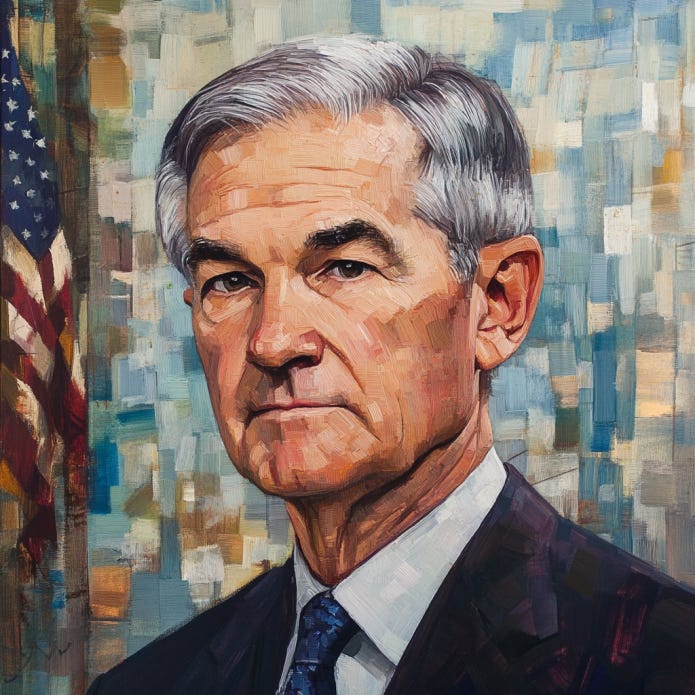Fed with Interest Rate "Hold" at 4.25%-4.50%: Powell & FOMC (January 2025)
Powell with an expected rate "hold" in January 2025
On January 29, 2025, the Federal Open Market Committee (FOMC) concluded its first monetary policy meeting of the year under an environment of moderating inflation and a stable labor market.
After lowering interest rates in prior meetings to accommodate easing inflation and an improving balance between jobs and workers, the Fed has now opted to hold the target range for the federal funds rate at 4.25%–4.50%.
Why It Matters:
Consumer Perspective: Sustaining a consistent interest-rate policy helps balance price stability and employment goals without abrupt changes that could unsettle household finances.
Business and Investment Landscape: With stable short-term rates but rising long-term yields, businesses must adapt to somewhat higher borrowing costs, while investors monitor how this mix affects equity valuations and risk premiums.
Policy Significance: The decision underscores the Fed’s belief that previous rate cuts have sufficiently recalibrated policy to maintain downward pressure on inflation and preserve gains in employment.
Macroeconomic Backdrop (January 2025)
Previously: Fed Cuts Rates 0.25% (December 2024)
Inflation Has Moderated
Headline PCE (Personal Consumption Expenditures) inflation is around 2.6% year-over-year, down significantly from its peak.
Core PCE sits near 2.8%, reflecting progress but still above the Fed’s 2% longer-term goal.
Key Moderators: Easing supply chain disruptions, tempered commodity prices, and slower gains in housing costs.
Labor Market Stays Solid
Unemployment remains at 4.1% and has been stable for about six months.
Monthly job gains average around 170,000, roughly aligning with new labor-force entrants.
Wage growth has cooled to around 3–4% annually—healthier than last year’s faster pace, reducing inflationary pressure but still supporting consumer spending.
Growth Around 2%
Preliminary data show real GDP growth slightly above 2% in 2024, driven largely by robust consumer spending.
Business investment remains positive, especially in tech and services, but higher interest rates are damping some capital expenditures.
Implications: This backdrop suggests inflation is on the right track, yet not so low that the Fed would consider additional cuts purely for stimulus. Meanwhile, consumers continue to spend, and job gains support steady incomes—potentially preventing an economic downturn, barring unforeseen shocks.
FOMC Monetary Policy Decisions
Rates on Hold
Target Range: 4.25%–4.50% for the federal funds rate.
Rationale: The FOMC views the current stance as “meaningfully restrictive,” strong enough to anchor inflation expectations but not so tight as to jeopardize labor market stability.
Forward Guidance: The Fed remains data-dependent, willing to act if inflation re-accelerates or if job market conditions worsen unexpectedly.
Implementation Note (Key Operational Tools)
The Implementation Note released alongside the policy statement clarifies the Fed’s operational stance. (LINK)
Interest on Reserve Balances (IORB): Held at 4.4%, ensuring banks have a stable return on reserves in alignment with the upper part of the policy range.
Primary Credit Rate (Discount Window): Held at 4.5%, providing short-term liquidity support to banks when needed at a modest premium over the policy rate.
Overnight Repo Facility: Minimum bid rate of 4.5%; $500 billion limit to absorb short-term liquidity demands.
Overnight Reverse Repo Facility: Set at 4.25%; a $160 billion per-counterparty limit, helping the Fed maintain the lower bound of the policy range.
Treasury Rollovers: Monthly cap of $25 billion in maturities; anything above is rolled over at auction.
Agency MBS Reinvestments: Monthly cap of $35 billion in runoff; amounts above are reinvested into Treasuries, preserving a steady reduction in the balance sheet.
Dollar Roll and Coupon Swaps: Allows minor transactions for smoother MBS settlement.
Implications: These tools collectively ensure the Fed can fine-tune liquidity and control short-term interest rates, while quantitative tightening (QT) continues at a measured pace to gradually reduce the size of the Fed’s balance sheet.
Detailed Economic Assessment
A.) Inflation Drivers
Housing: Slower rent inflation is easing overall price pressures; however, it still remains a notable contributor.
Consumer Goods: Many supply-chain bottlenecks have resolved, allowing certain durable goods to see price stabilization or declines.
Services: More closely tied to wages, service-sector inflation has receded but remains a pivotal area to watch.
Related: Consumer Price Index (CPI) Data (December 2024)
B.) Labor Market Balance
Hiring: Fewer overall job openings than last year, yet quit rates remain decent, indicating worker confidence.
Participation: Modest improvements in key demographics, although long-run trends such as aging population and immigration policy shifts could affect labor supply.
Wage Dynamics: Aligning more closely with productivity and the Fed’s inflation target, diminishing the risk of a wage-price spiral.
C.) Consumer Spending
Driving GDP: Consumers remain the engine of growth, benefiting from stable incomes, improved household balance sheets, and easing inflation.
Inflation’s Burden: While price levels rose substantially in prior years, the reduction in inflation’s pace relieves some pressure, especially for lower-income households sensitive to the costs of essentials.
D.) Housing Sector
Mortgage Rates around 7% keep housing affordability challenged, yet stable or slightly improving sales suggest the market may have adjusted.
Regional Variation: Housing can differ widely, with high-growth areas still contending with tight supply and elevated prices, while others face a soft patch.
E.) Policy Uncertainties and External Factors
Tariffs & Trade: Renewed tariff expansions or geopolitical tensions could reintroduce cost pressures and disrupt global supply chains.
Fiscal Policy: Changes to government spending or taxation can reshape the demand outlook, affecting both inflation and employment.
Global Slowdowns: If key trading partners show slower growth, U.S. exports and overall business sentiment might dampen.
Press Conference Highlights (Powell Q1 2025)
Political Pressures: Powell was asked about the President’s public remarks urging immediate rate cuts. He maintained the Fed’s independence and data-driven focus, confirming no direct contact on specific policy demands.
Long-Term Yields: Despite short-term rates holding steady or earlier cuts, 10- and 30-year Treasury yields have drifted higher, driven by term premiums and global factors—something Powell noted but did not see as a deterrent to current policy.
Asset Valuations: Some concern was raised about possible AI/tech bubbles. The Fed’s stance remains more about systemic risk than specific sector valuations, indicating no immediate tightening on that front.
Framework Review: The Fed reaffirmed its 2% inflation target would remain intact. A broader framework review is ongoing but is mainly about refining the Fed’s communications and policy strategies, not altering its fundamental objectives.
Crypto and Digital Assets
Fed’s Position: Chair Powell reiterated the Fed’s role in bank oversight, emphasizing that banks engaging in crypto-related services must do so safely and soundly. The Fed is not actively regulating the crypto market outside the banking perimeter—this largely remains the domain of other agencies and possible Congressional action.
Implications:
No Immediate Shift in the Fed’s policy tools in response to crypto.
Potential Legislative Changes could clarify the regulatory environment, influencing how traditional institutions adopt digital asset services.
Forward-Looking Implications
If Inflation Falls Further, Yet Steadily: The Fed might hold rates at the current level longer, allowing inflation to decline into 2% territory before contemplating rate cuts.
If Inflation Rebounds: Policy tightening could resume, complicating business investment and consumer credit costs.
If Labor Weakens Unexpectedly: The Fed could pivot to rate cuts to cushion a downturn, though only if inflation is near target.
Balance Sheet Watch: Quantitative tightening proceeds with monthly caps. Any emergent liquidity constraints (e.g., from bank funding stress) could prompt the Fed to adjust QT pace or expand repo facilities.
Considerations for Consumers, Businesses, Investors (January 2025)
For Consumers
Household Budgets: Slower inflation growth helps preserve purchasing power.
Interest Rates: Mortgage and personal loan rates remain high by recent historical standards, so prudent shopping for credit terms is vital.
For Businesses
Capex Planning: Steady short-term rates but rising long-term yields mean careful scheduling of capital investments.
Hiring and Wages: With the labor market balanced, businesses can strategize workforce expansion without the intense wage competition of previous years.
For Investors
Policy Certainty: The Fed’s commitment to data-driven decisions reduces surprise risks.
Watch the Yield Curve: Long-end rates are influenced by global demand, inflation expectations, and term premiums.
Risk Management: Markets remain susceptible to shocks—tariffs, geopolitical events, or unexpected inflation swings.
Bottom Line: The Fed’s posture aims for a “soft landing,” with inflation drifting toward 2% while preserving the stable employment gains achieved in recent years.
Final Take (FOMC January 2025)
With inflation moderating closer to 2% and unemployment stable at 4.1%, the Fed believes its current rate stance of 4.25–4.50% is both appropriately firm to contain price pressures and flexible enough to adapt to new data.
While external risks—like tariffs, potential changes to immigration, and global slowdowns—could shift the outlook, the Committee’s measured approach, ample operational tools, and emphasis on transparency leave it well-positioned to achieve its dual mandate of maximum employment and price stability.





